Twelve women huddled together, their last words ones of gratitude and praise. Stepping onto the still brightly lit Yates Street in downtown Victoria, they walked in pairs, straight-faced, unbothered by or unaware of the commotion they caused.
Each of them had come to understand that in their time together something significant had changed.
They had been practicing for three months, four hours every weekend at the Raino Dance loft studio, transforming some of their most heartbreaking and sacred stories into movement.
Tonight was their final performance.
Arriving at the legislative buildings, their line broke into a circle and the women joined hands. They took three deep, long breaths, until Mohawk artist Lindsay Katsitsakatste Delaronde started to sing Women’s Warrior Song, a resistance song gifted by members of Líl’wat Nation, to be sung in recognition of the many missing and murdered Indigenous women across Canada.
When the others joined in for the second chorus, loud bells of a nearby church interrupted, competing for attention.
This was their form of reconciliation.
The performance, called “ACHoRd,” was not a regular dance but the result of weeks of storytelling, healing and transformation. The group, comprised of Indigenous and non-Indigenous women, explored the theme of reconciliation by listening to and learning from one another, creating movements and strategies of support.
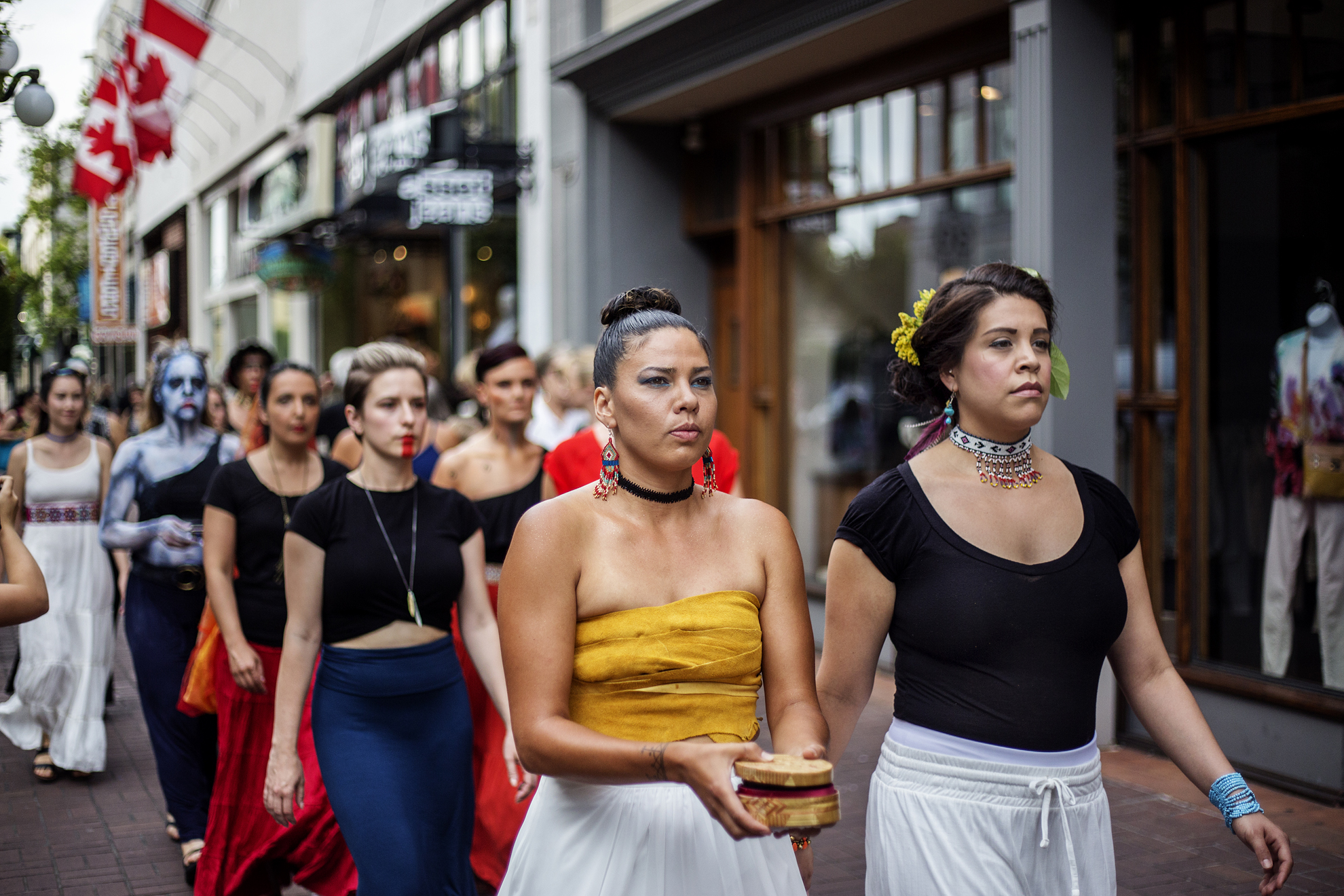
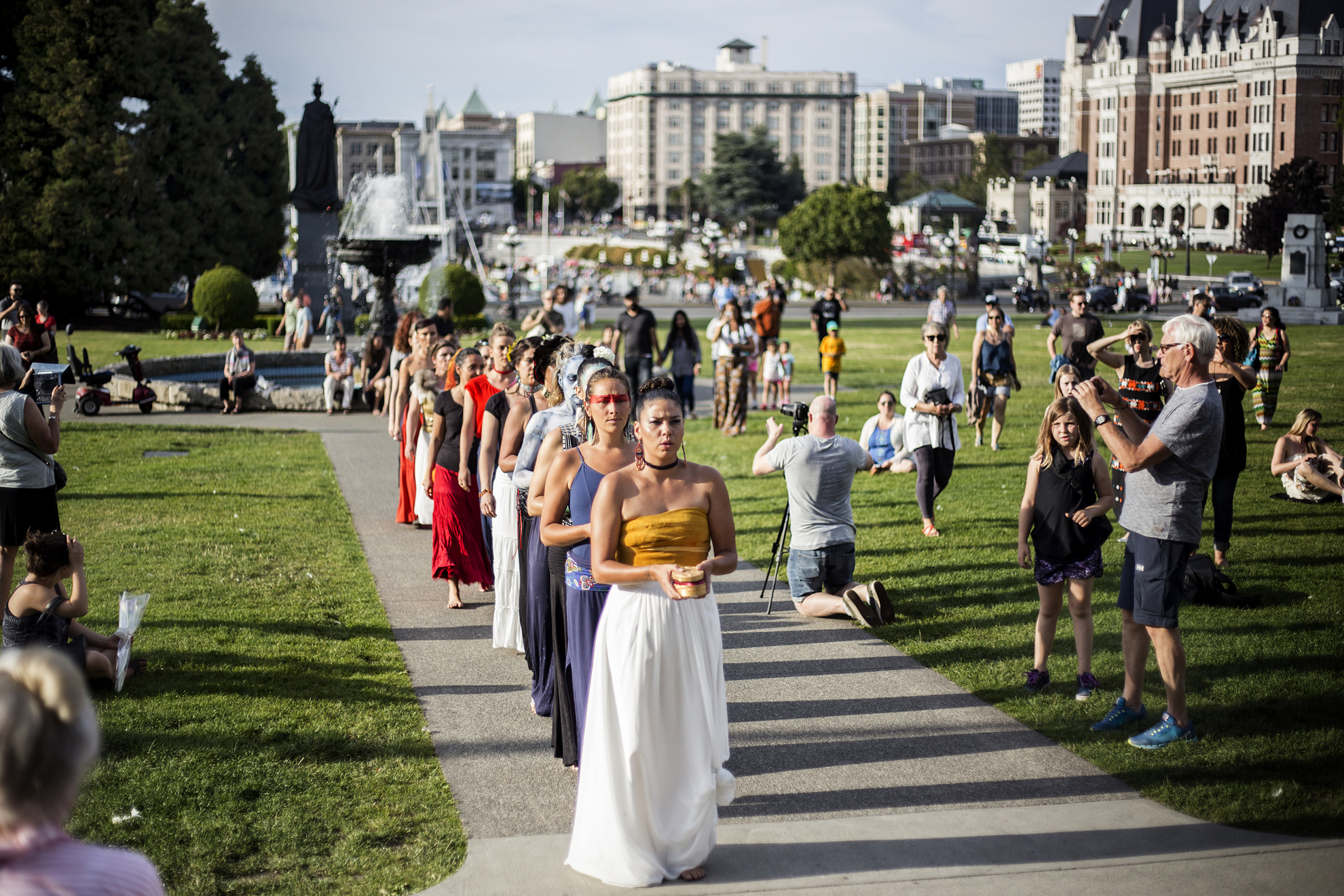
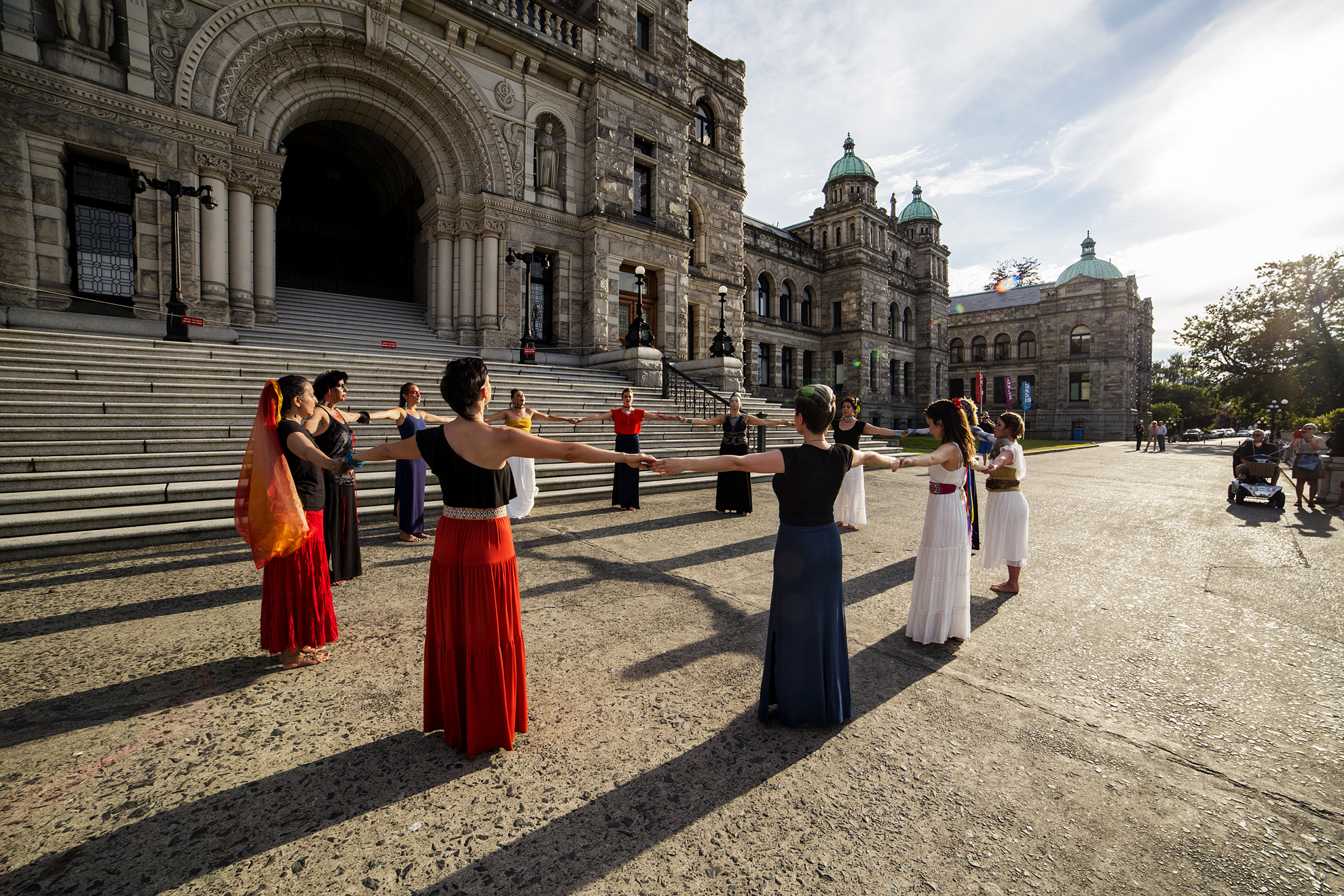
Reconciliation is one of the central objectives of Canada’s Truth and Reconciliation Commission, created as part of the Indian Residential Schools Settlement Agreement and focused on educating Canadians about the intergenerational impacts of our colonial relationships.
But the word reconciliation has been criticized by Indigenous communities that look to its definition — “to restore friendly relations” — and question the state of relations, both past and present, between Canada and its Indigenous nations.
In March, the City of Victoria named Delaronde as its Indigenous Artist in Residence. As part of her work, Delaronde wanted to explore the theme of reconciliation by inviting people to explore their political, personal and interpersonal relationships.
AChoRd, performed on a sun-soaked Sunday evening in June, was not Delaronde’s first public performance that involved engaging the community around social issues. In 2015, she walked through the streets of Montreal, 45 minutes from her home community in Kahnawake Mohawk Territory, dressed in regalia.
She stopped people and asked them if they knew which First Nations territory they were on, encouraging a community conversation around self-location, identifying oneself through a land-based and community-based lens, and the city’s relationship to its neighbouring Indigenous nations.
Last fall, Delaronde presented a photo series at the University of Victoria’s Legacy Art Gallery exploring Indigenous women’s sexualities. The exhibition, In Defiance, rejected the ways Indigenous women have been negatively stereotyped and provided a space for women to display their own expressions of sex and erotica.
Three months before ACHoRd’s public performance, Delaronde wandered around Victoria, looking for ways to activate the city. Coming upon the overbearing legislature building, she saw a stage already set.
“The Parliament building is a rallying point for the city,” she explained an hour before the performance, while painting on sharp eyebrows as if preparing for battle. “All kinds of communities use that space as a platform to speak.”
When Victoria programmers for Canada’s 150th celebration events asked Delaronde if they could include the ACHoRd performance on their events page, she agreed, with the firm understanding that what the dancers were celebrating was “something else.”
“We’re celebrating womanhood. We’re exposing our bodies on the Parliament building, reclaiming our stories and resisting colonialism,” Delaronde said.
While Delaronde has years of experience as a performance artist, she wanted to work with someone with professional dance training. She contacted Monique Salez, familiar with Salez’s experience with fusion art and collaborative cross-cultural work.
Owner and artistic director of the Raino Dance studio, a modern dance school for adults, Salez identified her role in ACHoRd as “more of a facilitator than a choreographer.”
“My work is about working through psychodrama and turning stories into movement,” she explained, sitting at the centre of the studio as dancers dressed, braided each other’s hair and painted limbs.
Although Delaronde and Salez had collaborated on managing the project, both said ACHoRd avoided hierarchy, taking on a form of its own.
For each dancer, a movement
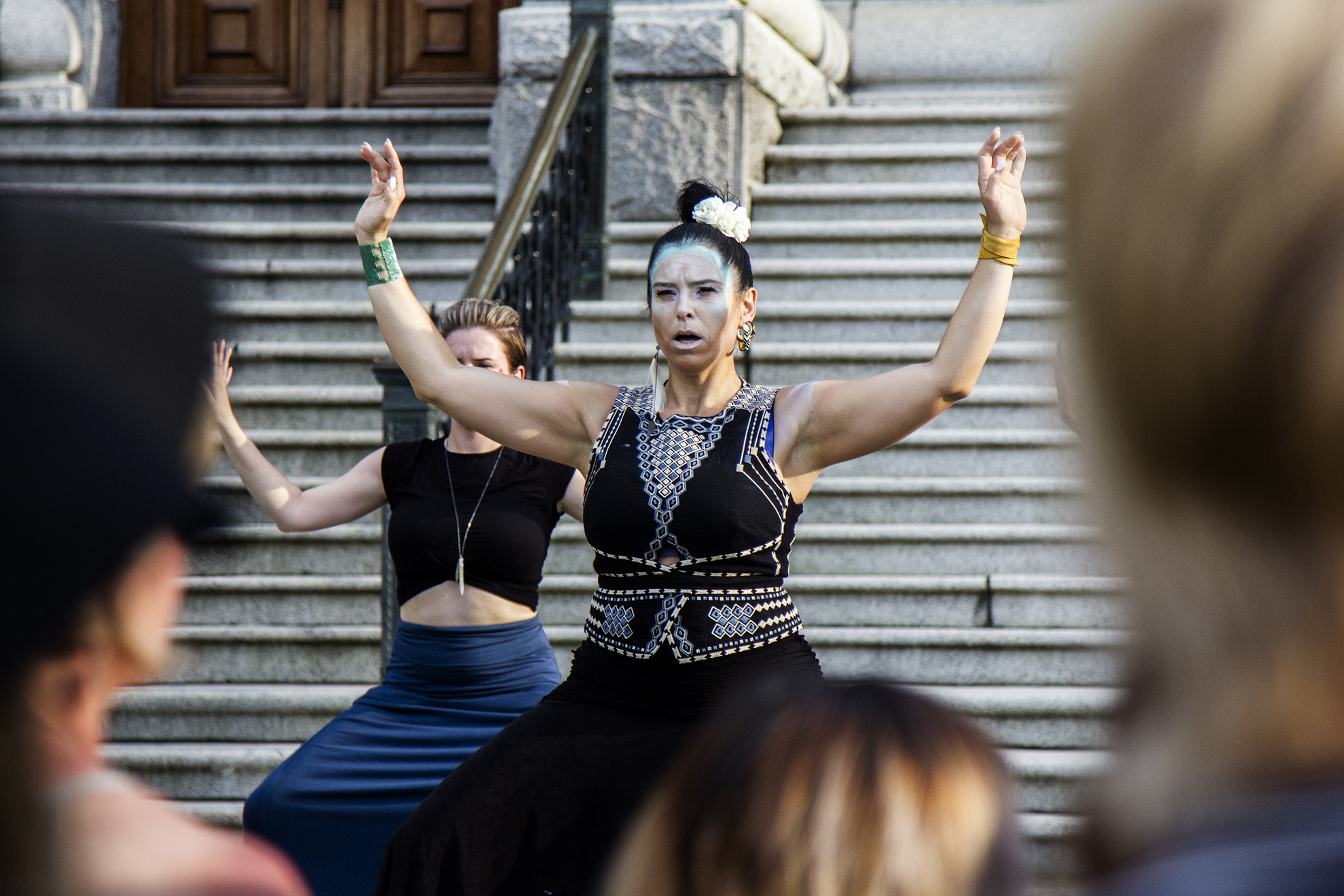
To find the dancers, Delaronde and Salez did a public call-out, reaching out to anyone who might be interested in their idea of embodied storytelling. When eight non-Indigenous and six Indigenous women responded, they felt confident that each member was meant to be a part of the process.
One of them was Denni Clement. For Clement, a member of the Ktunaxa Nation, it was a dream to receive the invitation. She had heard of Delaronde’s work, was drawn to her use of art to convey messages pertaining to the lived realities of Indigenous women and was already enrolled in classes at the Raino studio.
Clement had danced for almost as long as she had walked, starting with Powwow dancing as a fancy dancer, eventually transitioning to ceremonial dancing. She started figure skating at four and ballet in her early twenties.
“Dance has been a way for me to express myself and heal,” she explained over the phone. “Especially as an Indigenous woman who has felt like I haven’t had space in this society.”
With ACHoRd, Clement found a space that proved very different from any dance class she had ever taken. Delaronde made sure to include smudge, song and prayer in the sessions, medicines and practices that were an important part of the lives of many of the Indigenous dancers. The women were asked to introduce themselves by exploring the questions “Who am I?” and “Who am I not?”
“My whole life, I’ve grown up with these practices, passed down from my grandmothers,” Clement said. “We were talking about self-location right from the beginning, who we are and where we come from and sharing that practice with non-Indigenous peoples.”
For four hours every weekend over the next three months, the women worked with concepts introduced in Cree/Métis author Kim Anderson’s 2000 novel A Recognition of Being. Anderson’s work, exploring Indigenous womanhood, identified four stages of being: resistance, reclamation, construction and action.
Salez said she used those themes and other imagery in the novel to ask questions about the dancers’ own stories of resistance and reclamation.
“Instead of verbally asking for what we needed in times of struggle, we asked how our bodies could provide that support,” she explained. They listened to one another and watched each other’s body language, as they recounted difficult and often traumatic times, taking inspiration from what was being communicated without words, Salez said.
“It was one of the first times that I feel like I’ve had such a supportive audience to hear, respect and honour my experience,” Clement emphasized. “Oftentimes, Indigenous women are not heard and things are taken without consent. We’re abused in so many different ways, so to have a space to speak my truth and have it protected was life-changing.”
One dancer, who while walking back to the studio after the final performance introduced herself as “Wounded Bear,” had said in practice that she had needed to be seen and heard. So the dancers called out to her, waving and acknowledging her experience.
Another dancer had needed a pack of wolves surrounding her when she had felt abandoned, so they formed a tight circle around her and broke out into wild howls. For Clement, as she shared her experience, the group helped her envision being centered in a pack of warriors, surrounded by bows and arrows pointed outward.
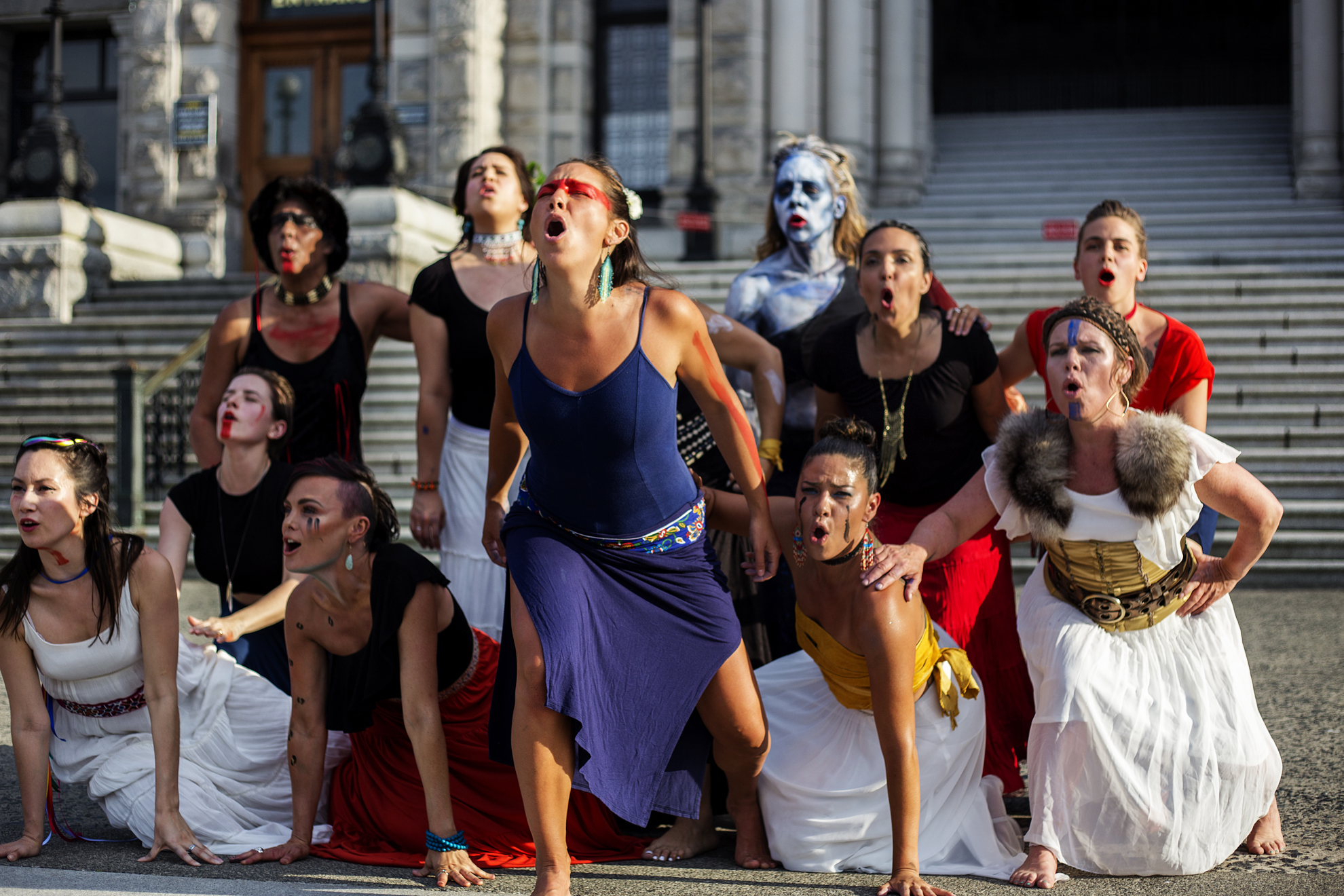
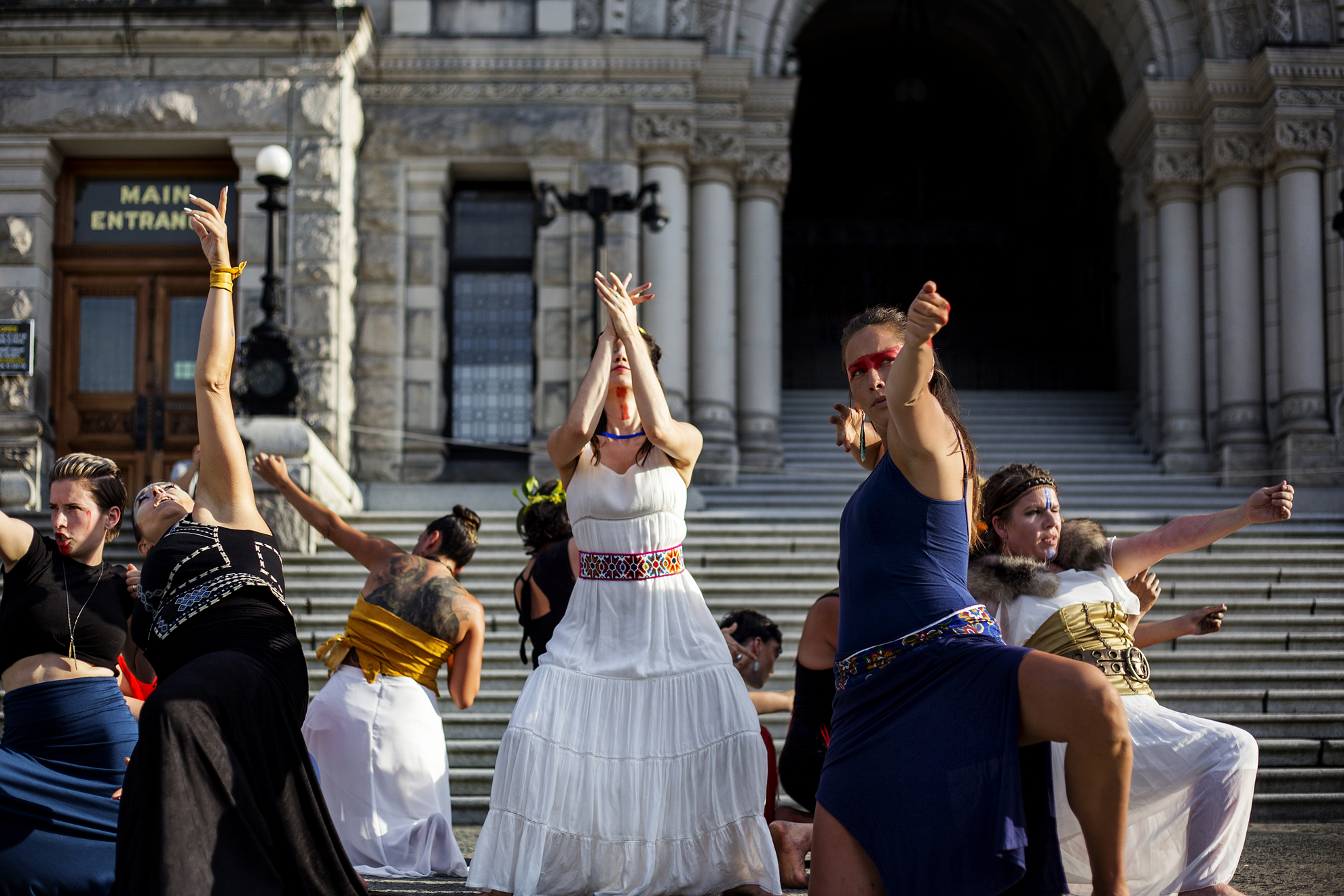
“Having the women doing the movements with me and expressing my pain, as well as joy, lightened the load,” she said. “It was almost like they were carrying the story with me, so I didn’t need to carry it all myself. It made the grief easier to carry.”
For Delaronde, who had unexpectedly lost her beloved partner two weeks before the practices began, the process allowed her to face her grief and thrust it to the sky. She asked the women to hold her entire body, as she lay as if on a bed of flowers, often with tears streaming down her face, and she surrendered to the hands of the other women who both held and heard her.
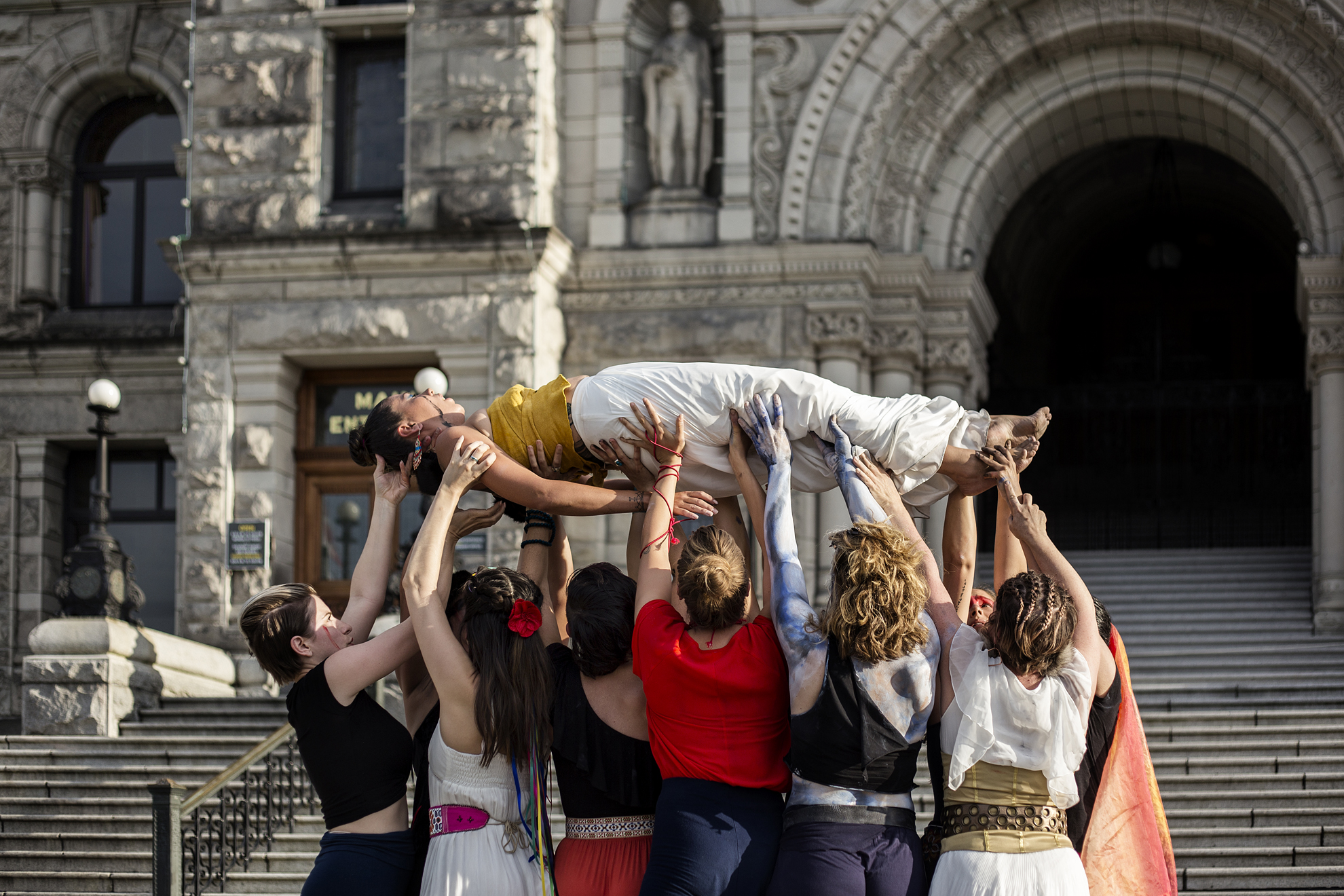
“It’s like we created a language of movement,” Clement explained.
The night before the performance, as Clement and Delaronde walked downtown, they saw an ACHoRd dancer and started doing “her movement,” the movement she created by expressing what she had once needed. “We didn’t have to speak,” she said.
But leading up to the performance, the women did enter into difficult dialogues, discussing cultural appropriation, self-location and identity. During one of the earlier practices, the idea of beading together to prepare their final regalia and costumes arose, and some women expressed their discomfort.
“It has taken generations to cultivate our beading traditions and it takes a lot of dedication to learn how to bead,” Clement had said in practice and again on the phone. A lot of traditional beading from her Ktunaxa nation is in the Royal British Columbia Museum. “We need someone’s approval, appointments and a guard to watch over us while we connect with the articles that are essentially our families, our spirits, our communities.”
By coming together, each woman shared her own wealth of diverse knowledge and gifts. Where some offered years of dance experience, others provided a rich depth of Indigenous worldviews and processes.
In choosing what to wear for their final performance, they agreed on skirts that, inspired by Anderson’s novel, represented their sacred shelters. The women were adorned by traditional jewelry, each piece holding a specific meaning.
“It was like seeing the true expression of all of us,” Clement explained, thinking back to the final night.
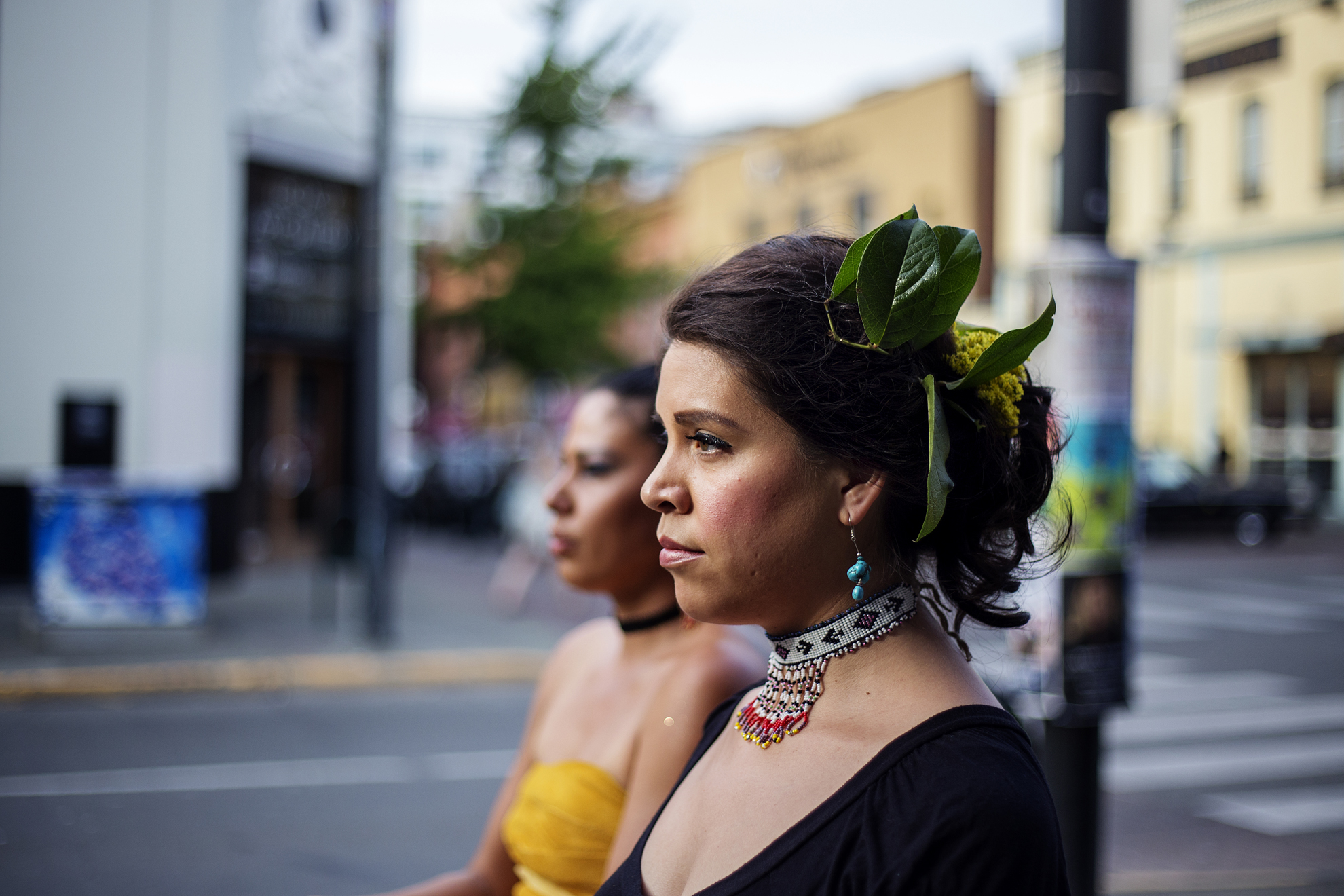
‘I think we’ve done powerful work’
The day before the performance, Clement, Delaronde and Cheryl Henhawke had walked the space, planning the movements. They made offerings and said prayers.
“It’s an institution that has oppressed us for centuries,” she said, speaking of the legislature building, “so for me, that was really important.”
“It isn’t only a performance, it’s a ceremony,” she added.
On the night of the performance, the dancers left the studio around 7 p.m., before the sun promised to set, and were flooded in golden light. “As we started to walk, I felt confident,” Clement said. “I said prayers to my ancestors and brought positive energy to the work we were doing.”
Clement said she felt the wind on her face and the sun beat down, as if the spirits were there with the women, protecting them. “The sky was incredible and that was a good sign,” she said and then laughed, “And the government has changed now, so I think we’ve done powerful work.”
“ACHoRd,” the title of the piece, felt more appropriate to use than anything directly linked to reconciliation, Delaronde and Salez explained.
Pronounced “accord,” the name is partly inspired by a Jamie Sieber song Mandlovu Mind that says “It is our grace to be a note in the exact chord that animates creation,” Salez explained. It was a quote that resonated with her.
Salez said she realized during the months of preparation that as a first generation Canadian, she had a lot of reconciliation to do as a settler. Her mother, who was born in a refugee camp in Germany, had immigrated to Canada when Salez was three.
Her mother’s parents were Hungarian, Gypsy and Polish and were born in concentration camps, Salez said. Her father’s family fled the Spanish revolution. “He moved to the South of France with his family and because of the poverty he experienced there, he immigrated here,” she said.
“I had been wrestling with my own self-location,” Salez said. “Who am I? Where do I sit in this whole picture? Where is my land and what does that mean?”
Salez said she does not yet have an answer, but feels more thoughtful about her “intersection with anything Indigenous.” She had deepened in her understanding of and relationship to indigeneity, she said, and felt proud of the relationships the women built. “That’s how it all begins,” she said.
Through the process of creating ACHoRd, a dance that holds the stories of many, the women gained more than just insight into one another’s cultures and nations. They sharpened skills that they could take back to their communities, families and front lines.
“We’ve developed tools of assertiveness and communication,” Delaronde explained. “These are transferable skills we’ve learned and can transfer to our children and families.”
Delaronde recently completed her second master’s degree in Indigenous communities counselling psychology at the University of Victoria. “Healing is a messy process,” she said.
Asked about larger efforts toward reconciliation across Canada, Delaronde said the dance collaboration shows one approach. “I think a process like this could be elaborated in all kinds of communities.”
Clement agreed.
“This is just the beginning for me,” she said. “I’m more empowered now to do this work. I feel like this is what I’m supposed to be doing with my life.”
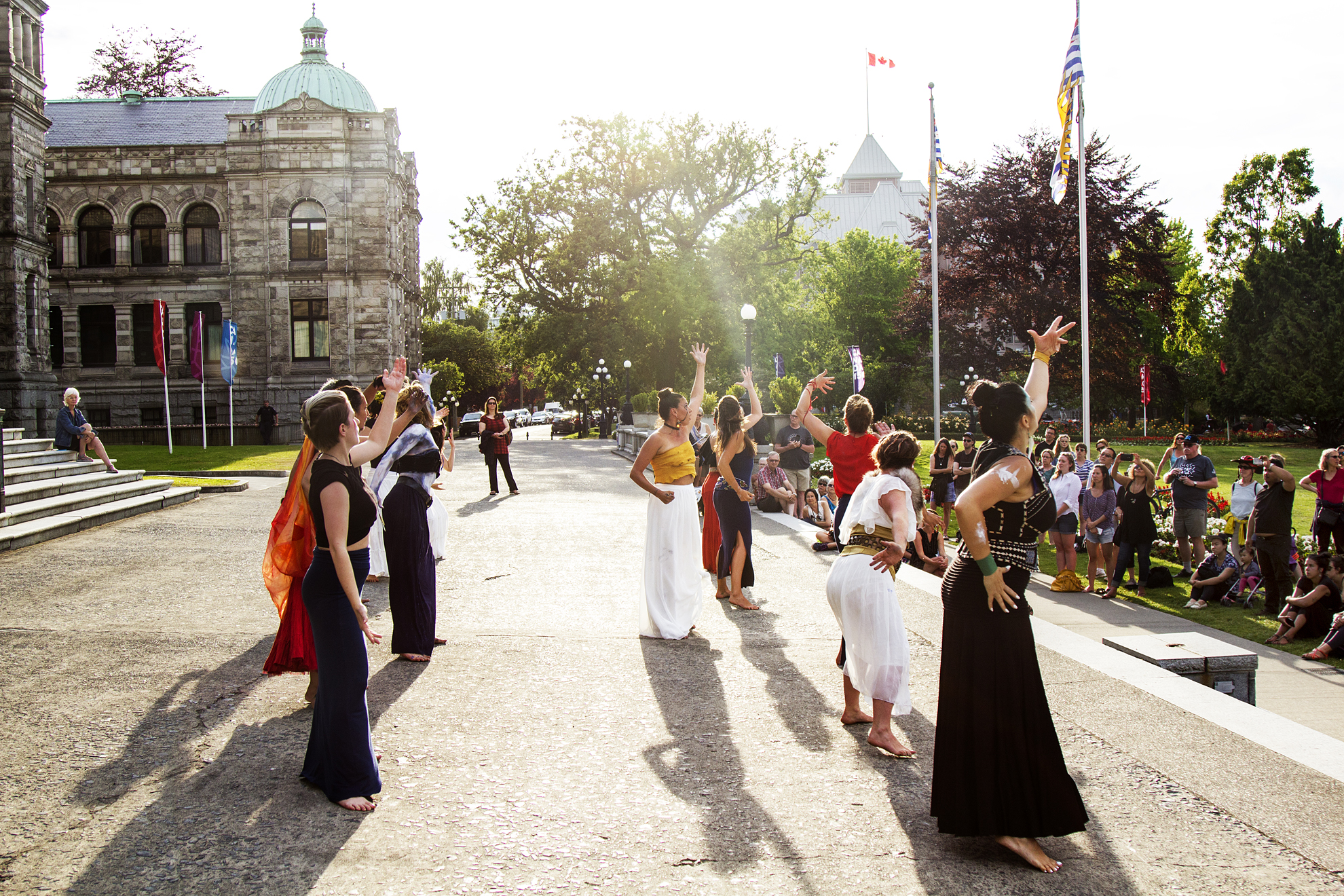
Read more: Indigenous




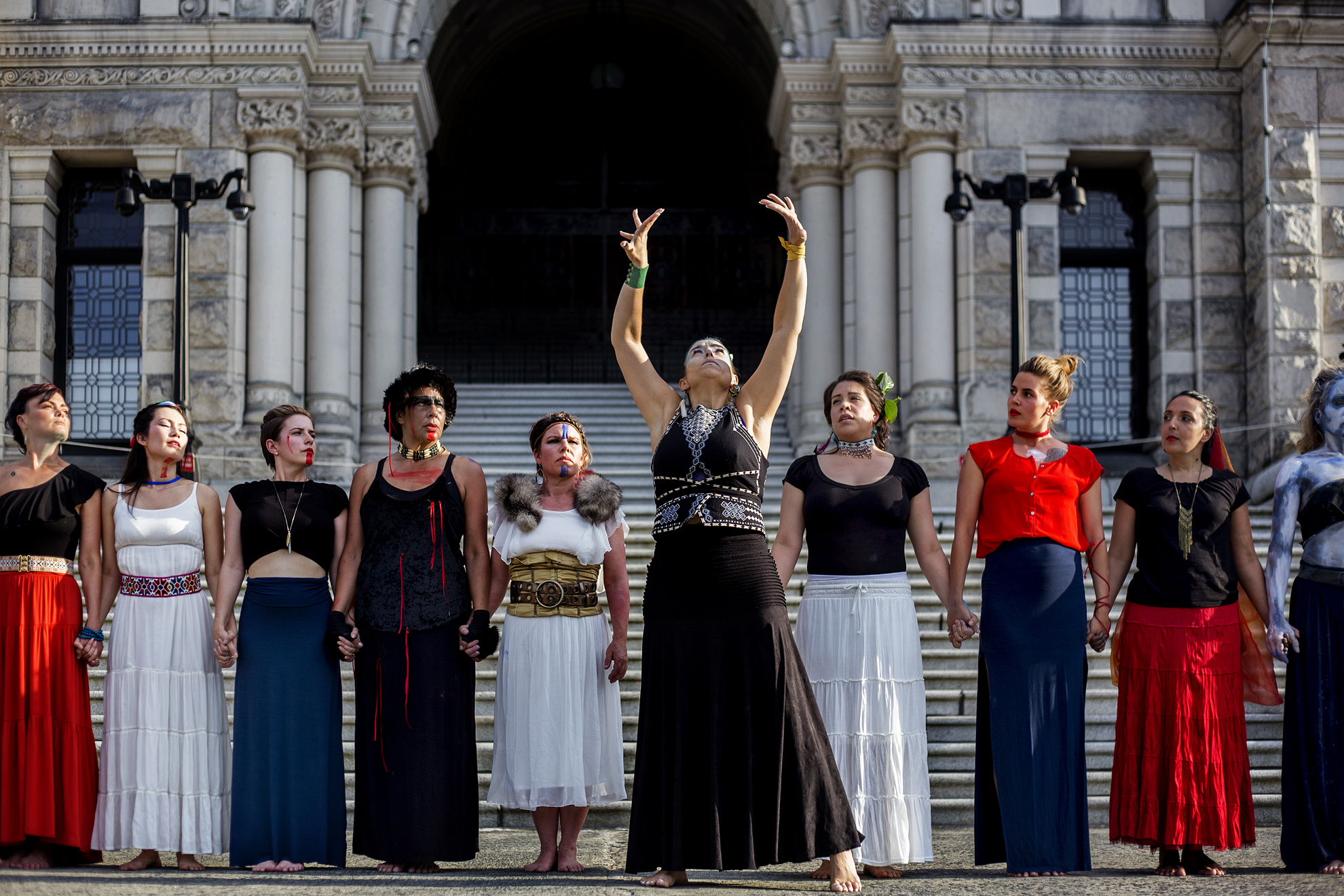












Tyee Commenting Guidelines
Comments that violate guidelines risk being deleted, and violations may result in a temporary or permanent user ban. Maintain the spirit of good conversation to stay in the discussion.
*Please note The Tyee is not a forum for spreading misinformation about COVID-19, denying its existence or minimizing its risk to public health.
Do:
Do not: